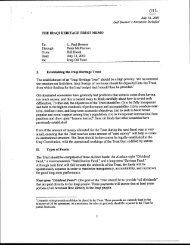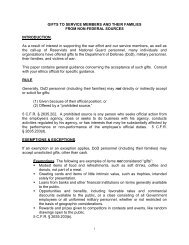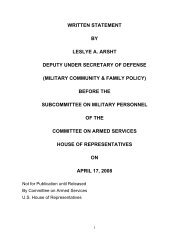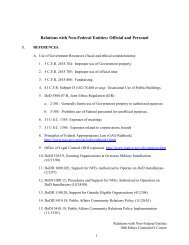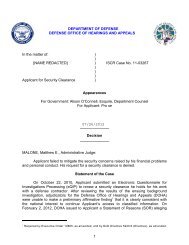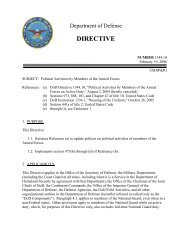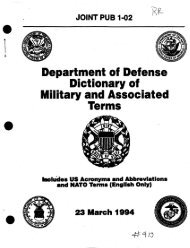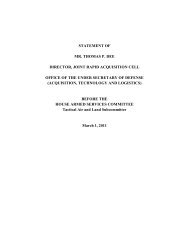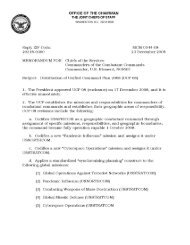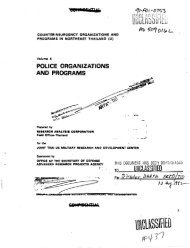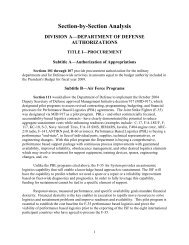dod tactical herbicide sites - United States Department of Defense
dod tactical herbicide sites - United States Department of Defense
dod tactical herbicide sites - United States Department of Defense
You also want an ePaper? Increase the reach of your titles
YUMPU automatically turns print PDFs into web optimized ePapers that Google loves.
(DNBP), pentachlorophenol (PCP), hexachloroacetone (HCA), and monosodiummethanearsonate (MSMA), pentachloro-pentenoic acid (AP-20), endothall, and variousmixed formulations <strong>of</strong> these desiccants. The systemic <strong>herbicide</strong>s included the two <strong>tactical</strong><strong>herbicide</strong>s Orange and White; the potassium salt, triisopropanolamine salts, and theisooctyl ester <strong>of</strong> picloram; and, a ethylhexyl ester <strong>of</strong> 2,4,5-T mixed with HCA. Mixtures<strong>of</strong> propanil, nitrophenol, linuron, and silvex were also evaluated. All chemicals werefurnished by Fort Detrick.Aerial application at these three <strong>sites</strong> were made with a Bell G-2 helicopter equipped withtwo 40-gallon tanks and a 26-foot boom with 6-inch nozzle positions adaptable forvolume deliveries <strong>of</strong> 3, 6, or 10 gallons per acre in a 50-foot swath. Spray equipment,pilot, and support were furnished under contract with Allied Helicopter Service <strong>of</strong> Tulsa,Oklahoma. Aerial applications were made on duplicate 3-acre plots, 200 by 660 feet indimension. A sampling and evaluation trail was established in each plot on a diagonalbeginning at 100 feet from one corner. Major species were marked along 500 feet <strong>of</strong> thistransect and individual plants were identified by combinations <strong>of</strong> colored plastic ribbons.A minimum <strong>of</strong> 10 individuals <strong>of</strong> each species was marked unless fewer were present.Evaluations were made at 1-, 5-, 10-, 30-, and 60-day intervals by experienced FortDetrick personnel. At each evaluation period the identical marked individuals <strong>of</strong> themajor species were rated for defoliation and desiccation. At each location, approximately475 gallons (~10 drums) <strong>of</strong> Herbicide Blue, 95 gallons (~2 drums) <strong>of</strong> Herbicide Orange,and 6 gallons <strong>of</strong> Herbicide White were expended.The assistance <strong>of</strong> <strong>Department</strong> <strong>of</strong> Army forestry personnel at Fort Gordon, Fort Chaffee,and the 3 rd and 4 th Army Headquarters were acknowledged in the report for their supportin the selection and preparation <strong>of</strong> <strong>sites</strong> in Georgia and Arkansas. The land and facilitiesfor the Florida tests were provided by the Supervisor, Apalachicola National Forest,Tallahassee, Florida. Personnel from the Physical Sciences Division, Fort Detrickassisted in the development <strong>of</strong> formulations and preparations <strong>of</strong> field test mixtures. Theyalso provided the data on the physical characteristics <strong>of</strong> the candidate <strong>tactical</strong> defoliantsand mixtures.Sources: Darrow RA, Frank JR, Martin JW, Demaree, KD, Creager RA (1971): FieldEvaluation <strong>of</strong> Desiccants and Herbicide Mixtures as Rapid Defoliants. Technical Report114, Plant Sciences Laboratories, Fort Detrick, Frederick, Maryland. Documentunclassified but subject to special export control. Available from the <strong>Defense</strong>Documentation Center, Accession Number AD 880685.50



